- Lithium Golf Cart Battery
- Forklift Lithium Battery
-
48V
- 48V 210Ah
- 48V 300Ah
- 48V 420Ah (949 x 349 x 569 mm)
- 48V 420Ah (950 x 421 x 450 mm)
- 48V 456Ah
- 48V 460Ah (830 x 630 x 590 mm)
- 48V 460Ah (950 x 421 x 450 mm)
- 48V 460Ah (800 x 630 x 600 mm)
- 48V 460Ah (820 x 660 x 470 mm)
- 48V 500Ah
- 48V 560Ah (810 x 630 x 600 mm)
- 48V 560Ah (950 x 592 x 450 mm)
- 48V 600Ah
- 48V 630Ah
-
48V
- 12V Lithium Battery
12V 150Ah Lithium RV Battery
Bluetooth App | BCI Group 31
LiFePO4 Lithium
Discharge Temperature -20°C ~ 65°C
Fast Charger 14.6V 50A
Solar MPPT Charging - 24V Lithium Battery
- 36V Lithium Battery
- 48V Lithium Battery
-
48V LiFePO4 Battery
- 48V 50Ah
- 48V 50Ah (for Golf Carts)
- 48V 60Ah (8D)
- 48V 100Ah (8D)
- 48V 100Ah
- 48V 100Ah (Discharge 100A for Golf Carts)
- 48V 100Ah (Discharge 150A for Golf Carts)
- 48V 100Ah (Discharge 200A for Golf Carts)
- 48V 150Ah (for Golf Carts)
- 48V 160Ah (Discharge 100A for Golf Carts)
- 48V 160Ah (Discharge 160A for Golf Carts)
-
48V LiFePO4 Battery
- 60V Lithium Battery
-
60V LiFePO4 Battery
- 60V 20Ah
- 60V 30Ah
- 60V 50Ah
- 60V 50Ah (Small Size / Side Terminal)
- 60V 100Ah (for Electric Motocycle, Electric Scooter, LSV, AGV)
- 60V 100Ah (for Forklift, AGV, Electric Scooter, Sweeper)
- 60V 150Ah (E-Motocycle / E-Scooter / E-Tricycle / Tour LSV)
- 60V 200Ah (for Forklift, AGV, Electric Scooter, Sweeper)
-
60V LiFePO4 Battery
- 72V~96V Lithium Battery
- Rack-mounted Lithium Battery
- E-Bike Battery
- All-in-One Home-ESS
- Wall-mount Battery ESS
-
Home-ESS Lithium Battery PowerWall
- 24V 100Ah 2.4kWh PW24100-S PowerWall
- 48V 50Ah 2.4kWh PW4850-S PowerWall
- 48V 50Ah 2.56kWh PW5150-S PowerWall
- 48V 100Ah 5.12kWh PW51100-F PowerWall (IP65)
- 48V 100Ah 5.12kWh PW51100-S PowerWall
- 48V 100Ah 5.12kWh PW51100-H PowerWall
- 48V 200Ah 10kWh PW51200-H PowerWall
- 48V 300Ah 15kWh PW51300-H PowerWall
PowerWall 51.2V 100Ah LiFePO4 Lithium Battery
Highly popular in Asia and Eastern Europe.
CE Certification | Home-ESS -
Home-ESS Lithium Battery PowerWall
- Portable Power Stations
How to Understand the Coremax 48V 100Ah LiFePO4 Rack-Mounted Battery Storage System

The Coremax 48V 100Ah LiFePO4 rack-mounted battery storage system is a cutting-edge energy solution designed for efficient power management and storage. Known for its safety, longevity, and high performance, this system is ideal for various applications, including renewable energy storage and backup power solutions.
What is the Coremax 48V 100Ah LiFePO4 battery storage system?
The Coremax 48V 100Ah LiFePO4 battery storage system is a lithium iron phosphate (LiFePO4) based energy storage solution that provides a nominal voltage of 48 volts and a capacity of 100 amp-hours. This translates to a total energy capacity of 4,800 watt-hours (Wh), making it suitable for various applications requiring reliable and safe energy storage.
Chart: Key Specifications of Coremax Battery
| Specification | Value |
|---|---|
| Voltage | 48V |
| Capacity | 100Ah |
| Total Energy Capacity | 4,800Wh |
| Chemistry | Lithium Iron Phosphate |
| Cycle Life | Up to 3,500 cycles |
What are the key features of the Coremax 48V 100Ah battery?
The Coremax LiFePO4 battery comes with several key features that enhance its performance:
- High Energy Density: Offers more energy storage in a compact design compared to traditional lead-acid batteries.
- Long Cycle Life: Capable of enduring up to 3,500 charge-discharge cycles, providing long-term reliability.
- Built-in Battery Management System (BMS): Monitors voltage, current, and temperature to ensure safe operation.
- Lightweight Design: Easier to handle and install compared to heavier alternatives.
- Enhanced Safety Features: Less prone to thermal runaway and equipped with overvoltage and overcurrent protection.
Chart: Features Overview
| Feature | Description |
|---|---|
| Energy Density | High density for compact designs |
| Cycle Life | Up to 3,500 cycles |
| Battery Management System | Monitors performance and safety |
| Weight | Lightweight for easy handling |
| Safety Features | Overvoltage/overcurrent protection |
How does the Coremax battery compare to other battery types?
When comparing the Coremax LiFePO4 battery to other types like lead-acid or lithium-ion batteries, several distinctions arise:
- Energy Density: LiFePO4 batteries have a higher energy density than lead-acid batteries but lower than some lithium-ion chemistries like lithium cobalt oxide (LCO).
- Cycle Life: The cycle life of LiFePO4 batteries significantly surpasses that of lead-acid batteries (typically around 300–500 cycles).
- Safety: LiFePO4 batteries are generally safer due to their thermal stability compared to other lithium-ion technologies that may pose risks of thermal runaway.
Chart: Comparison with Other Battery Types
| Battery Type | Energy Density (Wh/kg) | Cycle Life (Cycles) | Safety Profile |
|---|---|---|---|
| Lithium Iron Phosphate | 90-160 | Up to 3,500 | High |
| Lead-Acid | 30-50 | 300-500 | Moderate |
| Lithium Cobalt Oxide | 150-200 | Up to 1,000 | Moderate |
What applications are best suited for the Coremax battery?
The Coremax 48V 100Ah LiFePO4 battery is versatile and can be used in various applications:
- Renewable Energy Storage: Ideal for solar or wind systems where energy needs to be stored for later use.
- Backup Power Solutions: Provides reliable power during outages for residential or commercial use.
- Electric Vehicles (EVs): Suitable for EVs due to its lightweight design and long cycle life.
- Uninterruptible Power Supplies (UPS): Can be integrated into UPS systems for critical equipment protection.
Chart: Application Suitability
| Application Type | Best Suited For |
|---|---|
| Renewable Energy Storage | Solar/Wind systems |
| Backup Power Solutions | Residential/Commercial |
| Electric Vehicles | Lightweight energy needs |
| Uninterruptible Power Supplies | Critical equipment protection |
How do you install and maintain the Coremax battery system?
Installing and maintaining your Coremax LiFePO4 battery system involves several steps:
Installation Steps:
- Select an Appropriate Location: Ensure proper ventilation and accessibility.
- Mounting: Securely mount the rack according to manufacturer specifications.
- Connection:
- Connect positive (+) terminals first, followed by negative (-) terminals.
- Ensure all connections are tight and secure.
Maintenance Practices:
- Regular Monitoring: Check voltage levels and overall performance periodically.
- Clean Terminals: Keep terminals clean from corrosion or dust buildup.
- Temperature Checks: Ensure operating temperatures remain within recommended ranges.
Chart: Installation and Maintenance Checklist
| Task | Frequency |
|---|---|
| Voltage Monitoring | Monthly |
| Terminal Cleaning | Every six months |
| Temperature Checks | Quarterly |
Industrial News
The demand for lithium iron phosphate (LiFePO4) batteries continues to grow as industries seek safer, more efficient energy storage solutions. Recent advancements focus on enhancing performance metrics such as cycle life and charging speed while reducing costs through improved manufacturing processes. The increasing adoption of renewable energy systems further drives interest in robust solutions like the Coremax series.
Redway Power Expert Views
“Understanding how to properly install and maintain your LiFePO4 battery system is crucial for maximizing its lifespan,” states a Redway Power expert. “With proper care, these systems can provide reliable power solutions while contributing significantly to sustainability efforts.”
FAQ Section
Q1: What is a LiFePO4 battery?
A1: A LiFePO4 (Lithium Iron Phosphate) battery is a type of rechargeable lithium-ion battery known for its safety, long cycle life, and stable performance.Q2: How long do these batteries last?
A2: The Coremax LiFePO4 batteries can last up to 3,500 cycles under optimal conditions.Q3: Are there any special installation requirements?
A3: Yes, ensure proper ventilation during installation and secure all connections tightly.Q4: Can I use these batteries in extreme temperatures?
A4: While they perform well in moderate temperatures, extreme conditions can affect their efficiency.Q5: How do I maintain my Coremax battery?
A5: Regularly monitor voltage levels, clean terminals, and check operating temperatures.



















